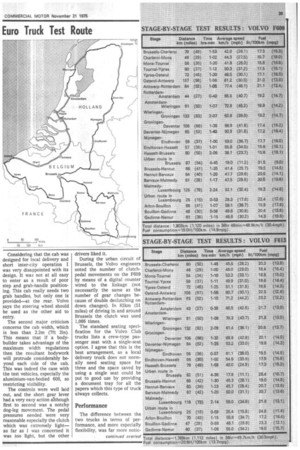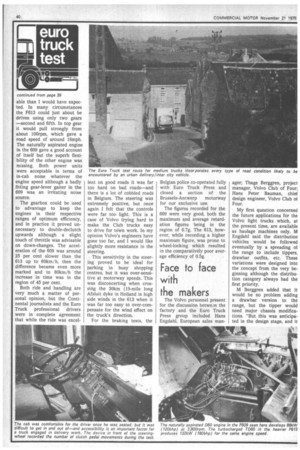Volvo F609 euro truck test and F613
Page 44

Page 45

Page 46

If you've noticed an error in this article please click here to report it so we can fix it.
by Technical Editor
THIS WEEK we publish the first full test report to appear in Britain on Club of Four vehicles : two of Volvo's new medium weight Club trucks—the F609 and F613. They were the subject of the third Euro Truck Press test in which CM has participated.
Both vehicles performed extremely well on the 1,800km (1,120-mile) test route through the Benelux countries, especially in having impressive fuel economy.
But although they were designed specifically for the urban delivery/inter-city type of operation, several basic features of the trucks clashed with this concept.
The Euro Truck Press route devised for mediumweight vehicles has two things in common with the longer heavy-truck route used for the Berliet and Volvo F89 tests already reported by CM—it starts in Brussels and it includes every type of road and traffic condition likely to be encountered by the average operator. Ordinary " A-road " operation was included in Belgium and Luxembourg while the performance in motorway inter-city conditions was evaluated in Holland.
To monitor the fuel consumption under typical urban delivery stop/start conditions a test route in the city centre of Brussels was used. In normal local delivery operation, a driver is given a load and a list of addresses in delivery order and sent on his way. This is what we did using 12 Fina filling stations scatter ed around Brussels as delivery points. As a local delivery truck starts full and finishes empty, a compromise was chosen for the fuel consump tion tests whereby both trucks ran at three-quarters of their maximum.
Joint design
Early in 1971 four truck manufacturers discussed the possibility of increasing their respective vehicle ranges with a light/medium truck : DAF, Magirus Deutz, Saviem and Volvo, who rapidly became known as the Club of Four although the resultant joint company was officially titled Societe Europeene de Travaux et de Developpernent, or ETD for short. . The whole basis of the cooperation was to cut costs by having joint design and purchasing agreements, the total quantities of components involved justifying bulk buying. A case in point is the gearbox, where a five-speed all-synchromesh box from ZF is used by the whole group.
The F609 and F613 models from Volvo have type numbers derived as follows.: F-forward control; 6—six-cylinder; 09 and 13-9 tons and 13 tons gvw respectively. The engine in the larger model was turbocharged while the other was naturally aspirated, both units being of Volvo design.
Both Volvos excelled themselves in the fuel consumption category. Taking the lighter model first the overall consumption was 19.01it/100km (14.9nripg) with the best figure of 14.31it/100km (19.8mpg) being achieved on the very last stage of the test between Gedinne and Namur in Belgium.
Apart from the simulated delivery run, the worst consumption was returned on the motorway section in Holland, but even so the figure of 21.11it/100km (13.4mpg) was still acceptable for an average speed of just under 50mph. The naturally aspirated engine certainly gave some consistent results as a study of the results panel will show. The Brussels urban circuit was, as expected, the most severe for the truck, and this was reflected in the fuel consumption of 31.51it/100km (9.0mpg), which is explained by the average speed in the heavy traffic of 18.0km/h (11.2mph). The same pattern was noticed when the results for the 613 were calculated; the motorway figures were again the worst. In the Brussels traffic, the " big " Volvo returned the slightly better fuel consumption of 26.41it/100km (10.7mpg) for a similar average speed.
Only at motorway speeds could one criticise the fuel consumption of the Club of Four Volvos and even then this was only in relation to the excellent figures achieved on the A and B-road sections. The tortuous Ardennes section Hannut-Barvaux-Malmedy was covered in fine style with little effort in either fifth or fourth gear for an average of nearly 30mph whereas the 38-tonners on Euro Truck tests (which use this same Belgian section) are usually in the low twenties. Considering that the cab was designed for local delivery and short inter-city operation I was very disappointed with its design. It was not at all easy to enter as a result of poor step and grab-handle positioning. This cab really needs two grab handles, but only one is provided-at the rear, Volvo says the steering wheel should be used as the other aid to entry.
The second major criticism concerns the cab width, which is less than 2,2m (7ft 2in). This means that if a bodybuilder takes advantage of the maximum width regulations then the resultant bodywork will protrude considerably beyond each side of the cab. This was indeed the case with the test vehicles, especially the aluminium-van-bodied 609, so restricting visibility.
The controls were well laid out, and the short gear lever had a very easy action although first to second was a notchy dog-leg movement. The pedal pressures needed were very reasonable especially the clutch which was extremely lightas far as I was concerned it was too light, but the other drivers liked it.
During the urban circuit of Brussels, the Volvo engineers noted the number of clutchpedal movements on the F609 by means of a digital counter wired to the linkage (not necessarily the same as the number of gear changes because of double declutching on down changes). In 82km (51 miles) of driving in and around Brussels the clutch was used 1,066 times.
The standard seating specification for the Volvo Club trucks lists a crew-type passenger seat with a single-seat option. I agree that this is the best arrangement, as a local delivery truck does not normally need seating space for three and the space saved by using a single seat could be put to good use by providing a document tray for all the papers which this type of truck always collects.
Performance
The difference between the two trucks in terms of performance, and more especially flexibility, was far more notic able than I would have expected. In many circumstances the F613 could just about be driven using only two gears —second and fifth. In top gear it would pull strongly from about 100rpm, which gave a road speed of around 18mph. The naturally aspirated engine in the 609 gave a good account of itself but the superb flexibility of the other engine was missing. Both power units were acceptable in terms of in-cab noise whatever the engine speed although a badly fitting gear-lever gaiter in the 609 was an irritating noise source.
The gearbox could be used to advantage to keep the engines in their respective ranges of optimum efficiency, and in practice it proved unnecessary to double-declutch upwards although a slight touch of throttle was advisable on down-changes. The acceleration of the 609 was around 25 per cent slower than the 613 up to 60km/h, then the difference became even more marked and to 80km/h the increase in time was in the region of 45 per cent.
Both ride and handling are very much a matter of personal opinion, but the Continental journalists and the Euro Truck professional drivers were in complete agreement that while the ride was excel lent on good roads it was far too hard on bad roads—and there is a lot of cobbled roads in Belgium. The steering was extremely positive, but once again I felt that the controls were far too light. This is a case of Volvo trying hard to make the Club trucks easy to drive for town work. In my opinion Volvo's engineers have gone too far, and I would like slightly more resistance in the steering.
This sensitivity in the steering proved to be ideal for parking in busy shopping centres, but it was over-sensitive at motorway speeds. This was disconcerting when crossing the 30km (19-mile long Afsluit dyke in Holland in high side winds in the 613 when it was far too easy to over-compensate for the wind effect on the truck's direction.
For the braking tests, the Belgian police co-operated fully with Euro Truck Press and closed a section of the Brussels-Antwerp motorway for our exclusive use.
The figures recorded for the 609 were very good, both the maximum and average retardation figures being in the region of 0.7g. The 613, however, while recording a higher maximum figure, was prone to wheel-locking which resulted in the comparatively poor average efficiency of 0.5g.








































































































